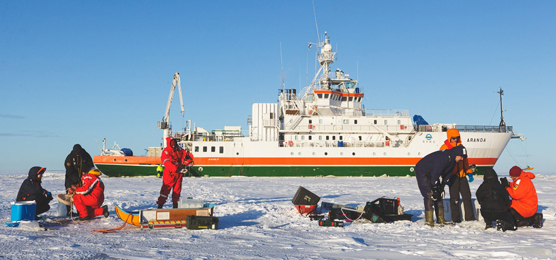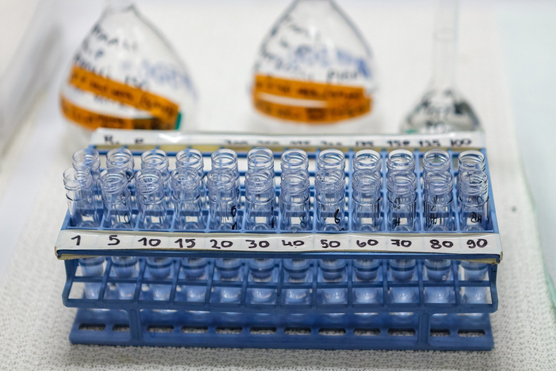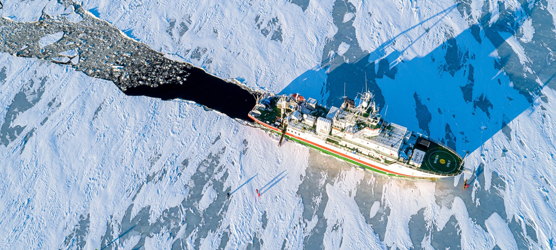Marine research facilities of the Finnish Environment Institute (Syke) include the research vessel Aranda and a wide range of research and analysis instruments and laboratory services.

Photo: Ilkka Lastumäki
Aranda – a modern, ice-strengthened marine research vessel
RV Aranda is a modern, ice-strengthened research vessel managed by the Finnish Environment Institute (Syke) and owned by the state of Finland. The vessel is adapted to demanding biological, physical and chemical research in the open sea. Aranda is a key element of the infrastructure for research and monitoring of the Baltic Sea.

Photo: Ilkka Lastumäki
Marine ecological research laboratory
The marine ecological research laboratory is part of Syke´s infrastructure supporting the marine research. The laboratory conducts experimental plankton research and is responsible for phytoplankton, zooplankton and benthos analytics.
The Marine Research Laboratory is involved in several international projects, which study the current state and future scenarios of the marine environment. In addition, Syke contributes to the development of the Utö Atmospheric and Marine Research Station, which is located in an excellent position for monitoring the state of the coastal sea and ship emissions.

Photo: Ilkka Lastumäki
FINMARI, Finnish Marine Research Infrastructure
FINMARI is the Finnish Marine Research Infrastructure consortium, coordinated by Finnish Environment Institute. FINMARI develops and maintains the national platform of facilities and instruments required for cutting-edge research of temporal and spatial marine processes and observation of the state and changes in the Baltic Sea through intensive, partly real-time, automatic measurements.
FINMARI enables long-term marine research and marine expertise in Finland which is high-quality even on a global scale. The information produced by FINMARI is not only utilized in basic research, but also in the development of monitoring and ecosystem models and the validation of satellite measurements.
Key projects
-
Blue Platform project
Funded through the EU Interreg Baltic Sea Region programme, the project compiles the information and materials produced in various blue bioeconomy projects in the Baltic Sea Region into an easily accessible form for all the relevant actors in the field. This information bank will also serve as a link to a bio bioeconomy network, composed of experts from different countries in the Baltic Sea Region and experts in various blue bioeconomy topics. The network will organize various events, produce more knowledge and provide information about topics in the field. The network will also produce reports to support decision-making in the EU.
-
Alliance+ project
Created in the previous Baltic Blue Biotechnology Alliance project, the purpose of the ALLIANCE network is to help new entrepreneurs in blue biotechnology to develop and test their ideas and turn them into products. Funded through the EU Interreg Baltic Sea Region programme, the Alliance+ project strengthens this existing network. New experts are recruited to the network and trained to act as mentors. The project also aims to identify investors interested in blue biotech to enable product development and business operations.
-
Spatial and Temporal Variability of Ambient Underwater Sound in the Baltic Sea
-
Application of hydrogen fuel cells in Arctic maritime transport (MARANDA)
Marine application of a new fuel cell powertrain validated in demanding arctic conditions
Publications
-
Environmental variables driving species and genus level changes in annual plankton biomass
Journal of Plankton Research, 2019
-
Spatio-temporal population dynamics of six phytoplankton taxa
Hydrobiologia, 2019
-
Reproductive rate of a top predator, the grey seal, as an indicator of the changes in the Baltic food web
Ecological Indicators, 2019
-
Community assembly and drivers of phytoplankton functional structure
Functional Ecology, 2017
-
Alien species: EU list should add potential invasives
NATURE Correspondence, 2016
-
Size matters more than shape: Ingestion of primary and secondary microplastics by small predators
Food Webs, 2018
-
Seafloor sediments as microplastic sinks in the northern Baltic Sea - negligible upward transport of buried microplastics by bioturbation
Environmental Pollution, 2019
-
Historical baselines in marine bioinvasions: Implications for policy and management
PLoS ONE, 2018
-
Phytoplankton species richness along coastal and estuarine salinity continua
American Naturalist, 2019
-
Comparison of diatoms and dinoflagellates from different habitats as sources of PUFAs
Mar. Drugs, 2019
-
Vernal phytoplankton bloom in the Baltic Sea: Intensity and relation to nutrient regime
J. Sea Res, 2018
-
Phytoplankton community composition and its changes in coastal Uusimaa 2010–2017 (in Finnish with abstract in English)
Uudenmaan elinkeino-, liikenne- ja ympäristökeskus: Raportteja 52/2019
-
Interlaboratory Proficiency Test 12/2017 Phytoplankton
Reports of the Finnish Environment Institute 6/2018
-
Phytoplankton species richness, evenness, and production in relation to nutrient availability and imbalance
Limnology and Oceanography, 2017
-
Approach for supporting food web assessments with multi-decadal phytoplankton community analyses – case Baltic Sea
Frontiers in Marine Science, 2016